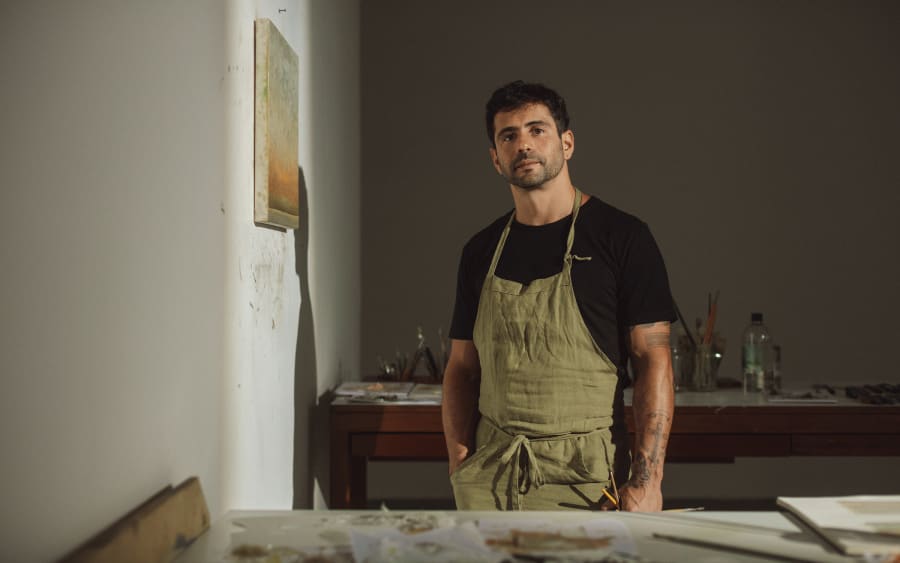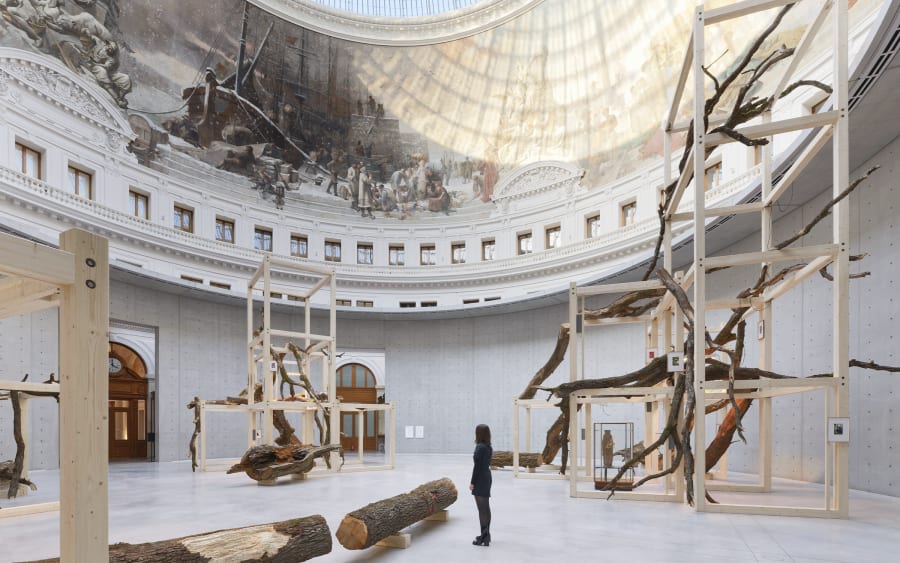‘My introduction to art came through my eldest brother, an art dealer specializing in the CoBra movement, working with artists like Karel Appel, Corneille, and Asger Jorn. But it wasn’t until my student years that contemporary art truly captivated me – thanks to Jan Hoet, the legendary director of S.M.A.K., the Museum of Contemporary Art in Ghent, Belgium. In 1986, Hoet curated ‘Chambres d’Amis’ [‘Guest Rooms’], a groundbreaking exhibition for which 50 Ghent residents opened their homes to internationally acclaimed artists to create site-specific works. Bruce Nauman, Juan Muñoz, Daniel Buren, Sol LeWitt…the list was remarkable. In our home, we hosted an installation by Günther Förg, and for three extraordinary months, the art world came to our doorstep. It was a profound experience that changed everything for me.
‘From then on, my passion for contemporary art became insatiable. I started collecting, unaware that collecting is a kind of obsession – it only intensifies over time. Despite my professional commitments, I spent every free moment visiting galleries, art fairs, and exhibitions. I had always been part of a culture that valued innovation, so this curiosity felt natural. Hoet became more than a teacher – he was a mentor, and a dear friend. He taught me invaluable lessons, starting with: ‘You need to know the ABC of art.’ He often reminded me, ‘How can you judge an artist if you don’t understand the context, the history, what came before?’ He taught me to truly see – to engage with the work physically and emotionally. To this day, I cannot buy a piece of art online; I need to stand before it, absorb it, feel its presence. When I began collecting regularly, he would invite me to the museum after hours so I could show him my latest acquisitions. He’d hang my works between two masterpieces – by Marcel Broodthaers and Joseph Beuys, for instance – to see if they could hold their own. These moments were formative, teaching me how to trust my instincts while recognizing the deeper layers within a piece. Not everything needs to be fully understood; great art has many layers and reveals itself over time.
‘Over the years, my approach to collecting has evolved. What began as an intuitive impulse became more measured, more intentional, more focused. I am drawn to artists exploring the human condition – love, violence, vulnerability, passion. Bruce Nauman and Thomas Schütte stand as pillars in this journey. Both explore the human condition with relentless curiosity and radical freedom. Both push boundaries, challenge the viewer, and work across diverse media – video, sculpture, drawings, neons in Nauman’s case, and for Schütte, sculpture alongside some of the most striking watercolors I’ve ever seen. Their work is provocative, yet often laced with humor and irony. They are, quite simply, artists’ artists. Franz West is another key figure in my collection. His sculptures, like the Onkel-Stuhl [Uncle Chair], invite viewers to interact and become part of the artwork. This same interactive relationship between art and viewer is something I also admire in Jason Rhoades.
‘I tend to collect in depth within each artist’s practice. Recently, I acquired a powerful piece by Rashid Johnson. While it explores anxiety, it’s layered with personal and historical narratives. Johnson’s ability to move seamlessly between painting, photography, and film fascinates me. Danh Vo is another artist I follow closely, as well as Tracey Emin and Wolfgang Tillmans. From the very beginning, I’ve been captivated by drawings – they offer an intimate window into an artist’s thought process. Francis Alÿs, with his poetic approach across drawing, painting, and video, resonates deeply with me. The same goes for Robert Gober’s haunting works and, more recently, Lucas Arruda’s meditative landscapes.
‘While contemporary art is my main passion, I’m equally captivated by beauty in all its forms – design, architecture, music, wine, and even automobiles – for instance, iconic cars like the Ferrari F40 and F50, or the Mercedes 300SL Roadster are indeed part of my collection. The Bauhaus taught us that art can be functional, but I also believe function can transcend utility and become art itself. During the pandemic, I felt compelled to create a space where all these worlds could come together, where art could exist alongside design, music, and architecture. The result is N.E.S.T., an acronym for Nurture, Enable, Share, and Transmit. It’s more than a collection – it’s an incubator for creativity. A place for young artists, musicians, and thinkers to collaborate, to be inspired, to create. With the help of architect Olivier Dwek, N.E.S.T. became a sanctuary where disciplines converge. For instance, I placed architectural interventions by Tadashi Kawamata, light works by Ólafur Eliasson, and glass works by Ritsue Mishima alongside pieces by Jean Prouvé, Charlotte Perriand, Le Corbusier, Jean Royère, and Martin Szekely.
‘The interplay between these objects and the art creates a powerful dialogue, where each elevates the other and transcends conventional categories. I also included a wine cellar and a space for concerts with a special Steinway & Sons Spirio | r Concert Piano. When art, design, music, and architecture come together in perfect harmony, the emotional response is extraordinary. It becomes a complete sensory experience – intimate, powerful, and transformative. Through N.E.S.T., I want to support young creatives – artists, musicians, thinkers – offering them a space to create, collaborate, and be inspired. Just as Jan Hoet nurtured me, I now hope to pass that same spirit forward. It’s my way of investing in the future.'
Florence Derieux is an art historian and curator.
English translation: Art Basel.
Published on April 16, 2025.
Caption for header image: Paul Thiers' office at N.E.S.T. in Eke, Belgium. Photograph by Senne Van der Ven & Eefje De Coninck for Art Basel.


